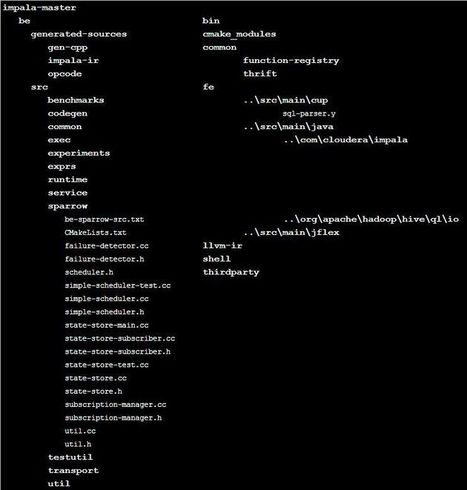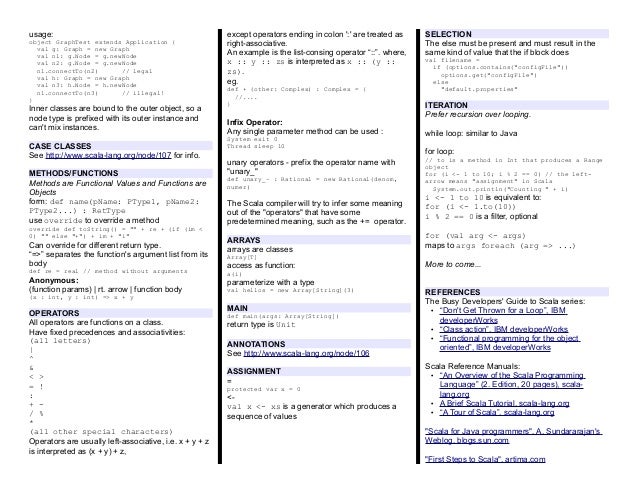This cheat sheet from here actually originated from the forum, credits to Laurent Poulain.We copied it and changed or added a few things.
Evaluation Rules
Since it's hard to search for scala syntactic constructions, hopefully this page might help. Note language coverage is incomplete. Source on github. Designed for scala 2.8 and 2.9. Portions adapted from A. Sundararajan's java vs. Scala cheat sheet: also check out. Scala implicitly converts the String to a RichString and invokes that method to get an instance of Regex. To find a first match of the regular expression, simply call the findFirstIn method. If instead of finding only the first occurrence we would like to find all occurrences of the matching word, we can use the findAllIn ( ) method and in.
- Call by value: evaluates the function arguments before calling the function
- Call by name: evaluates the function first, and then evaluates the arguments if need be
Higher order functions
These are functions that take a function as a parameter or return functions.
Currying
Converting a function with multiple arguments into a function with asingle argument that returns another function.
Classes
this references the current object, assert(<condition>) issues AssertionError if conditionis not met. See scala.Predef for require, assume and assert.

Operators
myObject myMethod 1 is the same as calling myObject.myMethod(1)
Operator (i.e. function) names can be alphanumeric, symbolic (e.g. x1, *, +?%&, vector_++, counter_=)
The precedence of an operator is determined by its first character, with the following increasing order of priority:
The associativity of an operator is determined by its last character: Right-associative if ending with :, Left-associative otherwise.
Note that assignment operators have lowest precedence. (Read Scala Language Specification 2.9 sections 6.12.3, 6.12.4 for more info)
Class hierarchies
To create a runnable application in Scala:
or
Class Organization

Classes and objects are organized in packages (
package myPackage).They can be referenced through import statements (
import myPackage.MyClass,import myPackage._,import myPackage.{MyClass1, MyClass2},import myPackage.{MyClass1 => A})They can also be directly referenced in the code with the fully qualified name (
new myPackage.MyClass1) Vlc filehippo com.All members of packages
scalaandjava.langas well as all members of the objectscala.Predefare automatically imported.- Traits are similar to Java interfaces, except they can have non-abstract members:
General object hierarchy:
scala.Anybase type of all types. Has methodshashCodeandtoStringthat can be overriddenscala.AnyValbase type of all primitive types. (scala.Double,scala.Float, etc.)scala.AnyRefbase type of all reference types. (alias ofjava.lang.Object, supertype ofjava.lang.String,scala.List, any user-defined class)scala.Nullis a subtype of anyscala.AnyRef(nullis the only instance of typeNull), andscala.Nothingis a subtype of any other type without any instance.
Type Parameters
Conceptually similar to C++ templates or Java generics. These can apply to classes, traits or functions.
It is possible to restrict the type being used, e.g.
Variance
Given A <: B
If C[A] <: C[B], C is covariant
If C[A] >: C[B], C is contravariant
Otherwise C is nonvariant
For a function, if A2 <: A1 and B1 <: B2, then A1 => B1 <: A2 => B2.
Functions must be contravariant in their argument types and covariant in their result types, e.g.
Find out more about variance inlecture 4.4and lecture 4.5
Pattern Matching
Pattern matching is used for decomposing data structures:
Here are a few example patterns
Scala Collections Cheat Sheet
The last example shows that every pattern consists of sub-patterns: itonly matches lists with at least one element, where that element is apair. x and y are again patterns that could match only specifictypes.
Options
Pattern matching can also be used for Option values. Somefunctions (like Map.get) return a value of type Option[T] whichis either a value of type Some[T] or the value None:
Most of the times when you write a pattern match on an option value,the same expression can be written more concisely using combinatormethods of the Option class. For example, the function getMapValuecan be written as follows:
Pattern Matching in Anonymous Functions
Pattern matches are also used quite often in anonymous functions:
Instead of p => p match { case .. }, you can simply write {case ..}, so the above example becomes more concise:
Collections
Scala defines several collection classes: Whitney houston will always love you instrumental.
Base Classes
Iterable(collections you can iterate on)Seq(ordered sequences)Map(lookup data structure)
Immutable Collections
List(linked list, provides fast sequential access)Stream(same as List, except that the tail is evaluated only on demand)Vector(array-like type, implemented as tree of blocks, provides fast random access)Range(ordered sequence of integers with equal spacing)String(Java type, implicitly converted to a character sequence, so you can treat every string like aSeq[Char])Map(collection that maps keys to values)Set(collection without duplicate elements)
Mutable Collections
Array(Scala arrays are native JVM arrays at runtime, therefore they are very performant)- Scala also has mutable maps and sets; these should only be used if there are performance issues with immutable types
Scala Syntax

Examples
Pairs (similar for larger Tuples)
Ordering
There is already a class in the standard library that represents orderings: scala.math.Ordering[T] which containscomparison functions such as lt() and gt() for standard types. Types with a single natural ordering should inherit from the trait scala.math.Ordered[T].
For-Comprehensions
A for-comprehension is syntactic sugar for map, flatMap and filter operations on collections.
The general form is for (s) yield e
sis a sequence of generators and filtersp <- eis a generatorif fis a filter- If there are several generators (equivalent of a nested loop), the last generator varies faster than the first
- You can use
{ s }instead of( s )if you want to use multiple lines without requiring semicolons eis an element of the resulting collection
Example 1
is equivalent to
Translation Rules
A for-expression looks like a traditional for loop but works differently internally
for (x <- e1) yield e2 is translated to e1.map(x => e2)
for (x <- e1 if f) yield e2 is translated to for (x <- e1.filter(x => f)) yield e2
for (x <- e1; y <- e2) yield e3 is translated to e1.flatMap(x => for (y <- e2) yield e3)
Scala Option Cheat Sheet
This means you can use a for-comprehension for your own type, as longas you define map, flatMap and filter.
Scala Cheat Sheet
For more, see lecture 6.5.
Scala Syntax Cheat Sheet
Example 2
Scala Cheat Sheet
is equivalent to
Scala Cheat Sheet Epfl
is equivalent to
